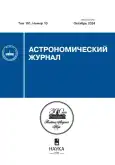Том 101, № 10 (2024)
- Год: 2024
- Выпуск опубликован: 15.10.2024
- Статей: 6
- URL: https://gynecology.orscience.ru/0004-6299/issue/view/10355
СТАТЬИ
Моделирование свободного падения струи газа на протопланетный диск
Аннотация
Проблему формирования экзопланет на наклонных орбитах по отношению к экваториальной плоскости родительской звезды или основной плоскости протопланетного диска можно решить путем введения наклонного диска меньшего размера. Однако остается открытым вопрос природы такого внутреннего диска. В данной работе успешно проверена гипотеза об образовании наклонного внутреннего диска в протопланетном диске около звезды типа T Tau вследствие падения на него струи газа. Для проверки гипотезы выполнены трехмерные газодинамические расчеты с учетом вязкости и теплопроводности при помощи пакета PLUTO. В ходе анализа расчетов показано, что однократное пересечение потоком вещества плоскости диска не может обеспечить образование наклонного диска вблизи звезды, в то время как двукратное – может. Кроме того, в случае ретроградного падения вещества угол наклона образовавшегося внутреннего диска значимо больше. Также был выполнен анализ наблюдательных проявлений данного события: потенциальное изменение блеска звезды, распределение оптической толщины по углам, эволюция темпа аккреции. Показано, что падение блеска может достигать 5m с учетом рассеянного света, причем подобное уменьшение яркости будет длиться несколько десятков лет. Кроме того, резкое увеличение темпа аккреции на два порядка потенциально может вызвать FU Ori-подобную вспышку.
 866-884
866-884


Распад рассеянных звездных скоплений и соотношение радиус-масса
Аннотация
Рассмотрены процессы образования и шесть механизмов распада рассеянных звездных скоплений (РЗС). Выполнены аналитические оценки скоростей распада РЗСв результате действия следующих механизмов: потеря начального газового компонента РЗС, потеря вещества из-за вспышек сверхновых звезд и образования планетарных туманностей, парные взаимодействия звезд РЗС, ускорение звезд двойными системами РЗС, взаимодействие звезд РЗС со звездами диска Галактики, столкновение РЗС с гигантскими молекулярными облаками (ГМО) на фронте спиральной волны. Разрушение РЗС сопровождается образованием звездного потока. Анализ соотношения радиус-масса ядра РЗС (RM) позволил сделать вывод о том, что оно, вероятно, не связано с механизмом распада и является продуктом эффектов наблюдательной селекции. Эволюция индивидуального РЗС в плоскости R–M определяется начальной плотностью и внешними условиями.
 885-902
885-902


Новый взгляд на структуру ближайшего околозвездного окружения звезды типа WTTS V718 Per
Аннотация
В статье анализируются особенности фотометрической и спектральной переменности молодой звезды V718 Per из скопления IC 348 с точки зрения ее возможной двойственности. Наиболее реалистичной выглядит модель, в которой главный компонент системы V718 Per A — звезда с эффективной температурой 5200 K — периодически экранируется двумя протяженными пылевыми структурами, состоящими из крупных частиц и движущимися вокруг звезды в резонансе с двумя планетами. Периоды их орбитального движения равны 4.7 года и 213 дням. Их отношение с высокой точностью равно 1:8, а отношение больших полуосей — 1:4. Массы планет не превышают 6 МJup. В моменты полных затмений V718 Per A в излучении системы доминирует более холодный компонент с эффективной температурой 4150 ± 100 K, что объясняет наблюдаемое в минимумах блеска покраснение звезды, а также изменения в ее спектре при переходе от яркого состояния к слабому. Спекл-интерферометрические наблюдения, выполненные на 2.5-м телескопе КГО ГАИШ МГУ, позволили оценить верхний предел на угловое расстояние между компонентами системы: ≤0.1′′, что эквивалентно проекционному расстоянию ≤30 а.е. Уникальная особенность этой системы состоит в том, что плоскости планетных орбит практически совпадают с лучом зрения. Такая ориентация системы наиболее благоприятна для измерений колебаний лучевой скорости звезды, вызванных орбитальным движением планет, а также для наблюдений транзитов планет по диску главного компонента системы.
 903-911
903-911


Пятенная активность карликовой звезды V772 Her
Аннотация
Рассмотрено фотометрическое поведение запятненного первичного компонента затменной системы звезд-карликов V772 Her (G0V + M5V) по многолетним многоцветным фотоэлектрическим наблюдениям. Общий фотометрический эффект, вызванный пятнами, доходит до 0.m19. Проведенное нами моделирование показало, что площадь запятненных областей может доходить до 13% полной поверхности звезды. Пятна холоднее невозмущенной фотосферы на 1800 К и располагаются в низких широтах.
 912-920
912-920


Новая формула для угловой скорости вращения жидких фигур равновесия
Аннотация
Целью работы является вывод новой динамической формулы для угловой скорости вращения фигур равновесия гравитирующей жидкости с политропным уравнением состояния. В этой формуле угловая скорость вращения зависит не только от показателя политропы 0 ≤ n ≤ 5, но, и это главное, от компонентов внутренней и внешней гравитационной энергии фигуры. При решении задачи постоянную интегрирования в полном потенциале удалось выразить через три глобальные характеристики: массу, полную гравитационную энергию и энергию вращения фигуры равновесия. Справедливость новой формулы подтверждена при n = 0 предельным переходом к классическим однородным сфероидам Маклорена и эллипсоидам Якоби. Результаты работы расширяют область применения теории фигур равновесия.
 921-928
921-928


Следует ли ожидать дальнейшего ускорения вращения Земли в ближайшие годы?
Аннотация
Недавно в печати было высказано предположение о том, что разница между всемирным и координированным временами UT1–UTC может достичь в ближайшие годы большого положительного значения (Agnew 2024). Это может сделать необходимым впервые в истории ввести в шкалу UTC отрицательную дополнительную секунду, что, в свою очередь, вызовет серьезные проблемы в системах хранения и синхронизации времени по всему миру. В настоящей работе на основе последних данных о вращении Земли и всемирном времени, публикуемых Международной службой вращения Земли и опорных систем отсчета (IERS), и их прогноза, показано, что тенденция к ускорению вращения Земли, наблюдаемая в течение последних четырех лет, скорее всего вскоре вернется к замедлению. Следовательно, опасения о возможной необходимости введения в ближайшие несколько лет отрицательной дополнительной секунды в шкалу времени UTC в свете последних наблюдательных данных выглядят безосновательными.
 929-936
929-936









